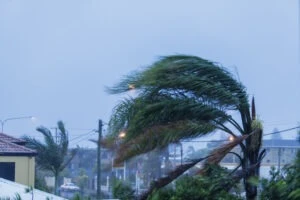
Knowing what to do if your business property is damaged or destroyed in a hurricane can help you protect yourself later with your insurance claim.
Our Corpus Christi commercial insurance claims lawyers explain the steps you should take below.
Ensure Safety and Document the Damage
When a hurricane has passed, the immediate aftermath can be disorienting and dangerous. Your top priorities should be ensuring the safety of everyone involved and gathering accurate records of the damage to support insurance claims and recovery efforts.
Prioritize Personal and Employee Safety
The first thing you must do is ensure that you and your employees are safe if anyone was on the property when the damage occurred.
Wait for Official Clearance Before Returning
If local authorities issued evacuation orders prior to the storm, do not return to the affected area until given official approval. Ensure that all employees are accounted for and are safe. Use a communication tree or emergency contact list if regular methods are unavailable.
Once clearance is given, only authorized personnel should enter the property for the initial assessment. If the property is in an unstable or high-risk area, consider bringing in a structural engineer or safety professional before entering.
When you enter the property, avoid floodwaters and downed power lines; both pose severe health and electrocution risks.
Conduct a Preliminary Damage Assessment
Before entering any structure, visually assess potential hazards such as:
- Cracks in the foundation
- Leaning walls or chimneys
- Roof sagging or collapse
Be cautious of animals, particularly snakes or rodents, which may have sought shelter during the storm.
Avoid Structural Risks
Do not enter buildings with visible signs of collapse or severe water damage unless a professional has declared them safe. Be alert for:
- The smell of gas (indicating leaks)
- Standing water around electrical systems
- Wet or moldy drywall, which could collapse or harbor bacteria
Use personal protective equipment (PPE) such as gloves, boots, goggles, and N95 masks if entry is absolutely necessary.
Thoroughly Document the Damage
Take Dated Photos and Videos: Capture wide-angle shots of entire rooms or structures, then take close-ups of individual items or damage. Include timestamps, and consider using a smartphone app or software that geotags and dates photos automatically. Photograph from multiple angles to provide a full context of the damage.
Make a Detailed Inventory of Affected Property: Record every damaged item, including office furniture, computers and electronics, machinery and tools, inventory, and stock.
For each item, include:
- Description
- Approximate value
- Model/serial number (if available)
- Purchase date
Use a spreadsheet or inventory app for clarity and accessibility.
Preserve Any Physical Evidence for Insurance Claims: Don’t dispose of damaged items until cleared by your insurance adjuster, unless they present a health hazard.
If you must remove debris for safety reasons, store a sample or take comprehensive documentation beforehand. Keep copies of all documentation, digital and physical, in a secure, backed-up location (e.g., cloud storage).
We have offices in Houston, Corpus Christi, and Victoria; and will travel to any corner of Texas if we are capable of preventing an injustice.

Notify Your Insurance Company
After ensuring safety and documenting the damage, contacting your insurance provider is one of the most critical steps in beginning the claims process. Prompt action can help minimize delays in restoring business operations.
Contact Your Business Insurance Provider Promptly
Use Emergency Claims Hotlines or Online Portals: Most insurers offer dedicated hotlines, mobile apps, or online claims portals for disaster situations. These tools are often the fastest way to initiate a claim, especially during widespread disasters when phone lines may be overwhelmed.
Contact methods may include:
- 24/7 disaster support numbers
- Online claim submission portals
- Local agents or brokers (if available and accessible)
Have Your Policy Number Ready: Before making contact, gather essential information:
- Business name and contact details
- Insurance policy number(s)
- Date and time the damage occurred
Keep both a digital and printed copy of your insurance policy in your disaster preparedness kit or cloud storage for quick access.
Understand Your Policy Coverage
Knowing what’s covered (and what’s not) is essential to managing expectations and making informed decisions during the claims process.
Property insurance typically covers physical damage to:
- The building structure (if owned)
- Equipment, furnishings, and inventory
- Fixtures and signage
Review whether your policy covers replacement cost or actual cash value (which deducts depreciation).
Business interruption insurance, also known as business income insurance, can cover:
- Replace lost income during forced closures
- Cover expenses like payroll, rent, and utilities
Flood vs. Windstorm Coverage Distinctions
Damage from wind (such as a torn-off roof) is typically covered by a standard property insurance policy. Flood damage (e.g., storm surge, rising water) is not usually included unless you have a separate flood policy, such as through the National Flood Insurance Program (NFIP).
You need to clarify:
- If wind-driven rain is covered
- If deductibles vary between wind and flood events
- Whether you have a named storm deductible (i.e., your losses are only covered if they are from a named storm)
Schedule an Adjuster Inspection
Once your claim is opened, your insurer will assign an adjuster to assess the extent of your losses. There are a few things you should do to streamline the process:
- Cooperate with insurer–assigned adjusters: Be present during the inspection, if possible, to answer questions, point out specific damage, and ensure nothing is overlooked. Prepare your documentation and walk the adjuster through your observations logically and professionally.
- Share all documentation and records: Provide:
- Your inventory of damaged items
- Photos/videos with timestamps
- Any temporary repair receipts or estimates
- Maintenance records or prior inspection reports (if relevant)
- Keep copies of everything you share for your own records and potential disputes.
Call An Attorney If You Encounter Issues
Even if you do everything correctly, insurers don’t always want to pay what you deserve. If the insurer refuses to pay what you deserve or is otherwise engaging in bad faith, get help from our Corpus Christi hurricane damage claim lawyers today.
Call Carrigan & Anderson, PLLC to get started now. We have decades of experience getting Texans the insurance payments they need.
At Carrigan & Anderson, PLLC we can talk to you about your options and rights.


